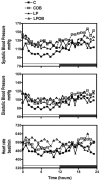Does early mismatched nutrition predispose to hypertension and atherosclerosis, in male mice?
- PMID: 20844591
- PMCID: PMC2936567
- DOI: 10.1371/journal.pone.0012656
Does early mismatched nutrition predispose to hypertension and atherosclerosis, in male mice?
Abstract
Background: A link between early mismatched nutritional environment and development of components of the metabolic syndrome later in life has been shown in epidemiological and animal data. The aim of this study was to investigate whether an early mismatched nutrition produced by catch-up growth after fetal protein restriction could induce the appearance of hypertension and/or atherosclerosis in adult male mice.
Methodology/principal findings: Wild-type C57BL6/J or LDLr-/- dams were fed a low protein (LP) or a control (C) diet during gestation. Catch-up growth was induced in LP offspring by feeding dams with a control diet and by culling the litter to 4 pups against 8 in controls. At weaning, male mice were fed either standard chow or an obesogenic diet (OB), leading to 4 experimental groups. Blood pressure (BP) and heart rate (HR) were assessed in conscious unrestrained wild-type mice by telemetry. Atherosclerosis plaque area was measured in aortic root sections of LDLr-/- mice. We found that: (1) postnatal OB diet increased significantly BP (P<0.0001) and HR (P<0.008) in 3-month old OB-C and OB-LP offspring, respectively; (2) that maternal LP diet induced a significant higher BP (P<0.009) and HR (P<0.004) and (3) an altered circadian rhythm in addition to higher plasma corticosterone concentration in 9 months-old LP offspring; (4) that, although LP offspring showed higher plasma total cholesterol than control offspring, atherosclerosis assessed in aortic roots of 6-mo old mice featured increased plaque area due to OB feeding but not due to early mismatched nutrition.
Conclusions/significance: These results indicate a long-term effect of early mismatched nutrition on the appearance of hypertension independently of obesity, while no effect on atherosclerosis was noticed at this age.
Conflict of interest statement
Figures





References
-
- Staessen JA, Wang J, Bianchi G, Birkenhager WH. Essential hypertension. Lancet. 2003;361:1629–1641. - PubMed
-
- Barker DJ, Winter PD, Osmond C, Margetts B, Simmonds SJ. Weight in infancy and death from ischaemic heart disease. Lancet. 1989;2:577–580. - PubMed
-
- Hales CN, Barker DJ. The thrifty phenotype hypothesis. Br Med Bull. 2005;60:5–20. - PubMed
-
- McMillen IC, Robinson JS. Developmental origins of the metabolic syndrome: prediction, plasticity, and programming. Physiol Rev. 2005;85:571–633. - PubMed
Publication types
MeSH terms
LinkOut - more resources
Full Text Sources
Medical
Molecular Biology Databases
Miscellaneous

